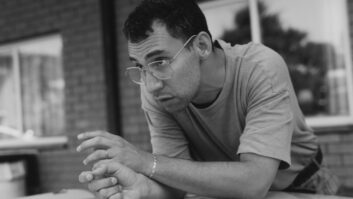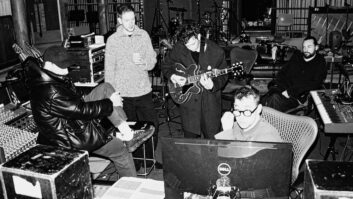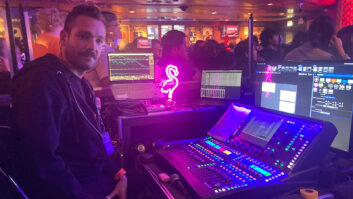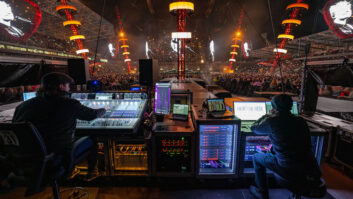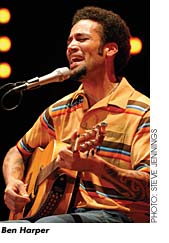
When Ben Harper is out on the road, he stays there for quite sometime. Currently supporting his latest studio album, Diamonds on theInside, Harper’s 18-month tour will take him from a large nightclubin L.A. to a small theater in Berlin to a blues festival in Byron Bay,Australia. Though he has never had a commercial smash album, hisacoustic jam-band-rock sound and continual touring have created a largecult following since the early ’90s. In much the same vein, JackJohnson got his touring chops from opening-act slots on previous Harpertours. This time around, though, the two are co-headliners, sharing thesame gear and sound crew. Mix caught up with the show inBerkeley, Calif.’s outdoor amphitheater, the 9,000-seat Greek Theater,toward the end of the summer leg. The band is then off for numerousdates through Europe and then back to the States for a slew of holidayradio shows and a run through the major markets.
SMALL WORLD
It can be a bit strenuous, says monitor engineer Derek Van Ord, tobe on your toes for Johnson and then turn around and mix for Harper.But the flipside of this double-duty is that both Van Ord and FOHengineer Michael Pollock (who declined to be interviewed) have beendoing sound for the two for many years and have their sound naileddown. “It just kind of happened,” Van Ord says about thelogistics in having one sound crew on this tour. “When Ben quittouring for a year-and-a-half, Jack continued touring with Michael.When Ben started touring again, it just made sense [to have bothPollock and Van Ord mix for both acts].” As for Van Ord, who hasbeen working with Harper since 1997, if it had been anyone besidesJohnson, he wouldn’t have signed on to do monitors for both. “Ilove Jack’s music: Low volume, so I don’t get beat up for Ben’sshow.”
While Van Ord stresses that mixing monitors for Harper and Johnsonwas challenging, it was alleviated somewhat in the fact that Harperowns most of the rig. “Michael and I got Ben on thatearly,” reveals Van Ord, “because when we first startedtouring with him, Ben wanted a very consistent sound, and to do that,you have to have the same gear. So we pushed Ben to start small: buyyour vocal microphone and then you have to buy a certain processor.Then, when he’s doing things on his own in L.A., he has all of his gearavailable and he can just put it in a studio and away hegoes.”

MAKING PERFECT FITS
Since they first came out, Van Ord was using the Midas HeritageH3000 console for Harper and on Weezer’s last tour. But on this tour,he made the switch to digital, opting to work with the InnovaSon GrandLive consoles for monitor and FOH because of their space-saving andweight-saving attributes. “With six guys in the band now, it isjust so much easier to have it all set. So I’m not carrying big racksof stuff. I can have a compressor on every channel. The console itselfis just a control surface and all of the digital conversion is done inthe stage box.” In that stage box are eight input cards that runon DOS — “It’s kind of clunky, but it’s superstable,” says Van Ord — and each input card offers two 266processors so that every four inputs has its own processor. The stagebox has four BNC co-ax outputs that, when used as a matched pair, twogo to FOH and two go to monitor, “sort of like a digitalsplit,” Van Ord points out.
“The InnovaSon is a little easier for FOH than for monitorsbecause you can only view a single input or a single mix at one time.So if you have to do a handful of changes at once, it can be a littleslow. But once you get used to the whole process, you can actually doit pretty quickly.”
Van Ord comments that by the end of this leg of the tour, the GrandLive was jam-packed, using all of the console’s 48 processing channels,24 outputs and 56 inputs. “I’ve got 20 output faders and then onthe mix box, I have 24 processed outputs for backups and opening bandsand other mixes.” As for the vocal chain, Van Ord relays thateverything he uses is all built-in onboard with the system.
While Van Ord has switched consoles only twice, he has jumped tofour different in-ear manufacturers for Harper: from Shure E1s, toSensaphonic 2X and Pro4 models, to Future Sonics single-driver models,and currently to Ultimate Ears UE7s and UE5 ambient models. “WhenI was on tour with Weezer, I started a relationship with Ultimate Earsand I really liked their product and their field support isunparalleled. My goal is, Number One, hearing conservation and thennumber two, to make everybody happy. We’re trying to keep as low of astage volume as possible; the in-ears have definitely freed me up tonot contribute to that stage volume.”
Harper uses a single driver and a pair of wedges, which areMicrowedges originally designed by Rat Sound. “They’relow-profile, 12-inch with 2-inch co-ax compression drivers that arecommercially produced by Radian because they have Radiancomponents.” Newly hired guitar player Marc Ford only uses15-inch Rat Sound wedges, and bassist Juan Nelson is on one in-ear.Mixes for each of the bandmembers are straightforward: Whatever isfurther away from where each member is playing onstage is predominatelylouder in the mix. Harper gets just himself with a little bit ofkeyboards in his wedges.
Before this tour, Johnson wasn’t using in-ears at all. But duringthe second leg of the summer tour, Johnson approached Van Ord to“try them out.” “I got him using them for a good twoweeks,” Van Ord recalls. “He went with a single one, aswell, because he’s such a soft singer and just to have his vocal bemore present. I just use Ben’s gear for the drummer [Adam Topol, whoseusing Shure E1s].” Johnson receives a bit of himself and a littlebit from bassist Merlo Podlewski.
WHAT YOU DON’T OWN, RENT
Van Ord has had a working relationship with Rat Sound since he firstrented from the company in ’97, including numerous rentals of thecompany’s Rat trapezoid proprietary cabinets on previous Harperoutings. On this tour, he is renting the FOH P.A. (an L-AcousticsV-DOSC and dv-DOSC — a first for this tour) and monitor wedges.“The P.A. is fantastic,” Van Ord enthuses. “You saveso much on truck weight, it sounds fantastic and, for me, you don’t getall of the noise coming out from the back of the boxes.
“We use anywhere from eight to 12 cabinets with three dv-DOSCboxes underneath and then arrays out for pitfills. We also use the dvsfor pitfills, because they are so nice and low-profile that you canjust slap them on the stage and nobody sees them.” The system canbe enlarged to accommodate larger venues with 36 V-DOSC boxes and atleast a dozen dv-DOSC enclosures.
“We’re leaving for Europe soon, and the whole P.A. system thatwe used on the summer tour is right now in a cargo container on a boatheading over to Norway. We figured why break up a good thing?”Van Ord asserts. “The crew that we had was fantastic. So, wethought, ‘Let’s keep it consistent. It works, let’s go withit.’”
Sarah Benzuly is Mix’s associate editor.
Select Gear List
Mics: Shure Beta 98s (Harper’s drummer/percussionist LeonMobley: “Especially with the percussion player; there were somany dog-gone things to mike. He has more channels than half theband!” jokes Van Ord.); Beta 57As (Harper’s backup vocals); ShureWH20 headset microphones (Harper’s drummer/percussionist); Audix D2(toms); Audix MTX1 (underheads); Audix D6 and Beta 91 (kick); Beta 57Aand e609 (snare); VP88 (overhead)
Beltpacks: Sennheiser SR 3056 U
Outboard Receiver: Sennheiser EK3053 U
Cabinets: Demeter 212, Marshall 410 driven by a Demeter head,custom Rockaforte head


